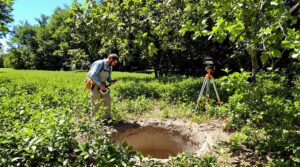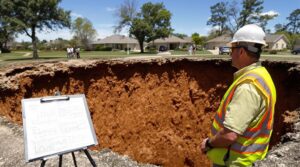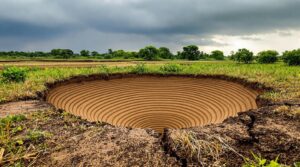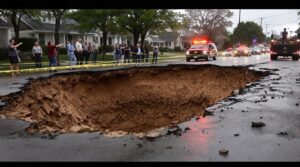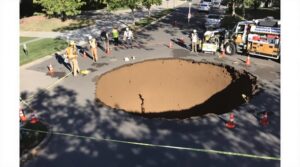When a sinkhole appears in a yard, property owners must first contact emergency services (911) for immediate safety assessment. Local authorities and public works departments should be notified next to evaluate public infrastructure risks. Insurance providers require prompt notification to initiate claims. Professional assessment from geotechnical experts and structural engineers determines the full scope of damage. A licensed public adjuster can maximize claim settlements and guide property owners through complex remediation processes.
Key Takeaways
- Contact emergency services (911) immediately if the sinkhole poses an immediate threat to life or property.
- Call your local public works department or municipal engineering office for initial assessment and guidance.
- Notify your homeowner's insurance company to report the sinkhole and initiate a potential claim.
- Reach out to a licensed geotechnical engineer or geological expert for professional evaluation of the sinkhole.
- Contact utility companies to check for damaged underground infrastructure that could worsen the sinkhole.
Emergency Response Steps for Yard Sinkholes
When a sinkhole appears in a yard, immediate and methodical emergency response steps are essential to guarantee safety and prevent further damage. The initial phase requires a careful assessment of the sinkhole's dimensions, depth, and proximity to structures while maintaining a safe distance from the affected area.
Property owners must immediately contact emergency services and local authorities who can provide professional guidance and assistance. Simultaneously, establishing a secure perimeter through barricades and warning signs helps prevent accidents and injuries. Notifying adjacent property owners about potential sinkhole causes enables community-wide safety awareness. Since many yard sinkholes result from collapsed plumbing, contacting utility companies for pipe inspection is crucial.
Documentation through photographs and videos serves dual purposes: providing vital information for emergency contacts and specialists while supporting future insurance claims.
During this process, it remains important to avoid actions that could worsen the situation, such as introducing water into the cavity. Continuous monitoring of the sinkhole's development helps inform emergency responders and specialists about changes requiring immediate intervention.
Identifying Warning Signs and Danger Zones

Early detection of sinkholes requires property owners to recognize specific warning signs and high-risk zones that indicate potential ground instability. Key indicators for sinkhole identification include sudden depressions in the yard, foundational issues such as buckling or cracking, and localized patches of dead vegetation.
Property owners should also monitor for uneven floors, sagging structures, and water pooling patterns. Old trash pit locations can develop into dangerous sinkholes as buried materials decompose over time.
Geological factors play a significant role in determining sinkhole susceptibility. Areas with limestone and dolomite compositions present heightened risk, particularly when combined with specific land features like swales and drainage basins.
Infrastructure vulnerabilities, such as damaged stormwater pipes and poorly compacted soil around utilities, further increase the likelihood of sinkhole formation.
Additional risk factors include buried construction debris and a history of sinkhole activity in neighboring properties. Property owners should be particularly vigilant during periods of heavy rainfall, as water infiltration can accelerate void formation beneath the surface.
Local Authorities and Professional Resources
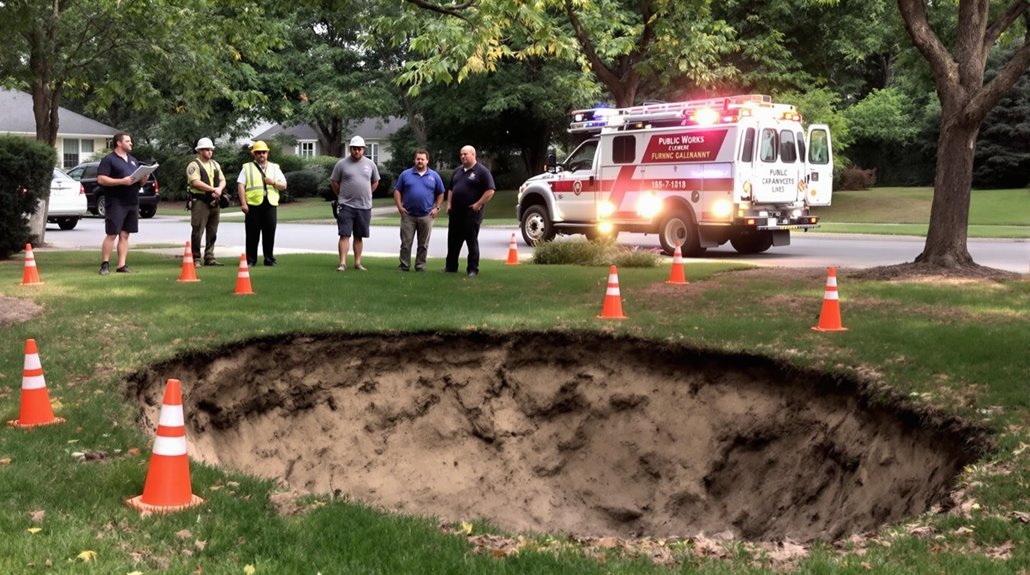
Responding effectively to a sinkhole requires property owners to contact multiple authorities and professionals based on the severity and location of the ground failure. Emergency services and local public works departments should be notified immediately when sinkholes pose public safety risks or affect infrastructure. Given aging infrastructure concerns, property owners must prioritize immediate reporting to prevent further deterioration of underground utilities.
For thorough assessment of sinkhole causes and determination of appropriate repair methods, property owners should engage geotechnical experts and licensed contractors specializing in ground stabilization.
- Coordinate with utility service providers to evaluate potential damage to underground infrastructure and prevent service disruptions.
- Consult hydrogeologists and structural engineers to analyze subsurface conditions and develop targeted repair strategies.
- Engage municipal engineering offices for technical guidance and compliance with local regulations regarding sinkhole remediation.
The involvement of qualified professionals guarantees proper documentation for insurance claims while facilitating the implementation of effective, long-term solutions for property stabilization and public safety maintenance.
Safety Measures and Immediate Actions
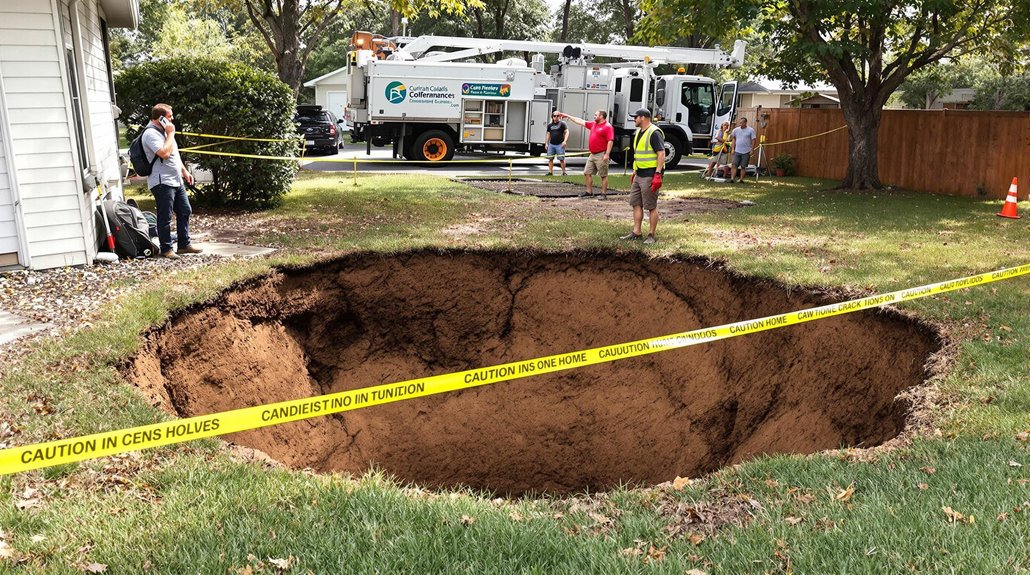
Upon discovering a sinkhole, immediate implementation of safety protocols and containment measures becomes critical to prevent accidents and protect both people and property.
The first steps in sinkhole safety involve securing the affected area by establishing a safe perimeter using rope or warning tape, followed by evacuating any threatened structures.
Property owners must promptly assess the situation while maintaining a safe distance from potentially unstable edges. Key immediate actions include notifying relevant authorities, insurance providers, and utility companies.
For sinkholes in public areas, implementing crowd control measures and establishing barriers becomes essential to prevent unauthorized access.
Regular monitoring for signs of expansion or instability should continue while awaiting professional assessment. Observable indicators such as ground depressions, foundation cracks, or changes in water quality require documentation.
These safety measures remain in effect until qualified professionals can evaluate the sinkhole's severity and determine appropriate stabilization methods.
Long-Term Prevention and Property Protection
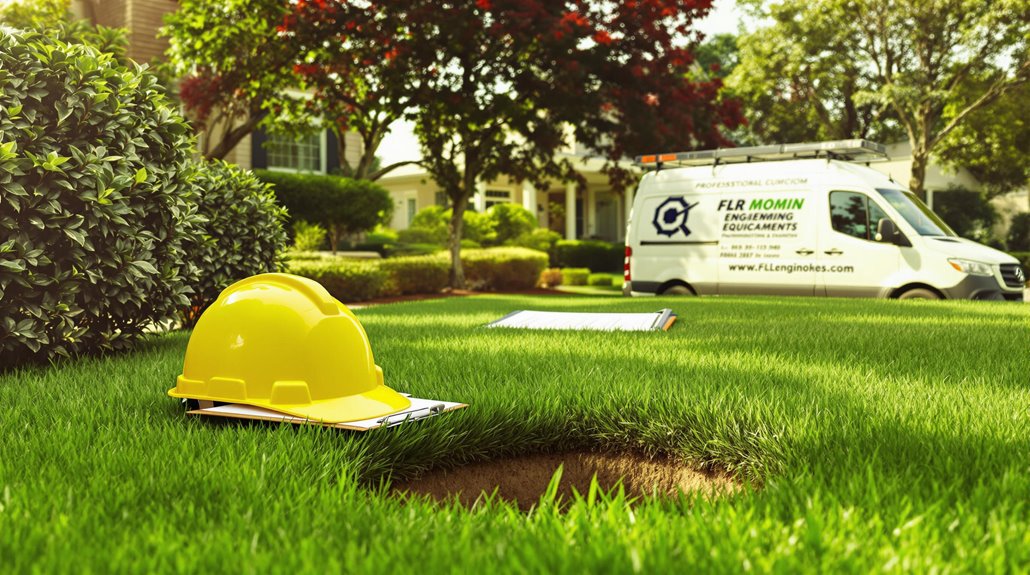
Thorough long-term prevention of sinkholes requires a multi-faceted approach incorporating geological monitoring, structural reinforcement, and proper water management systems.
Property owners can implement preventive measures through regular geological surveys, groundwater monitoring, and professional sinkhole testing. Engineering solutions, such as subsurface grouting and adapted structural designs, greatly enhance property resilience against sinkhole formation.
To guarantee thorough protection, property owners should consider:
- Installing reinforced foundations or floating slabs to distribute structural loads more effectively
- Implementing proper drainage systems to prevent water infiltration and soil erosion
- Maintaining active sinkhole insurance coverage with clear understanding of policy terms
Regular maintenance combined with proactive structural improvements forms the foundation of effective sinkhole prevention.
Professional engineering assessments, coupled with continuous monitoring of geological conditions, enable early detection and intervention. These strategies, supported by appropriate insurance coverage, provide thorough protection against potential sinkhole-related damages.
The Benefits Of Consulting A Public Adjuster
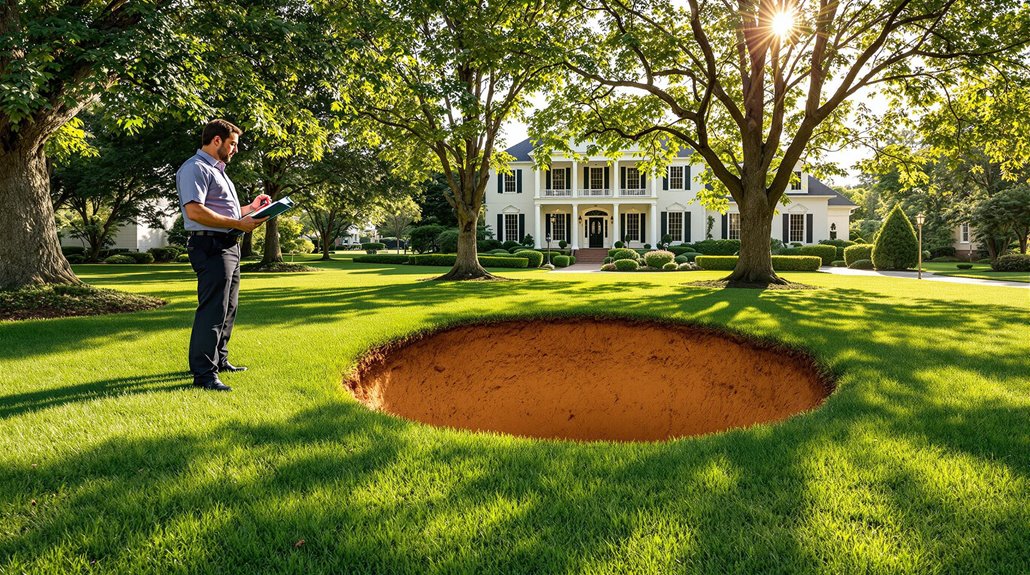
When dealing with sinkhole damage, consulting a public adjuster provides specialized expertise in steering through complex insurance claims and guarantees thorough documentation of all structural impacts.
A public adjuster's objective assessment utilizing advanced inspection tools helps identify both visible and concealed damage patterns that could affect claim validity.
Their dedicated policyholder advocacy typically results in more extensive settlements while reducing the administrative burden on property owners throughout the claims process.
Studies show that working with licensed public adjusters can increase settlement amounts by up to 500% compared to handling non-catastrophe claims without professional assistance.
Expertise In Insurance Claims
Steering a sinkhole insurance claim requires specialized knowledge and expertise that public adjusters can provide. Through thorough insurance policy interpretation and claims process navigation, these professionals guarantee policyholders receive maximum benefits under their coverage.
Their understanding of insurance company procedures and tactics enables them to effectively advocate for fair settlements while maintaining regulatory compliance.
- Public adjusters meticulously document evidence, damage assessments, and repair estimates to build robust claim presentations.
- They leverage their expertise to identify all covered damages, guaranteeing no legitimate claims are overlooked or underpaid.
- Their negotiation skills and familiarity with insurance tactics help counter attempts to minimize claim settlements.
Working on a contingency fee basis, public adjusters offer their specialized services without upfront costs, while their involvement often results in higher settlement values that offset their fees. The fee structure model typically involves charging up to 10% of the total claim settlement, ensuring their interests align directly with achieving maximum compensation for policyholders.
Objective Damage Assessment
An objective damage assessment conducted by a public adjuster provides property owners with extensive documentation and expert analysis of sinkhole-related damages.
Through thorough sinkhole inspection protocols, public adjusters utilize specialized equipment like ground penetrating radar to identify both visible and concealed structural issues that may not be immediately apparent.
The resulting damage report serves as essential documentation for insurance claims, detailing the full scope and cause of the property damage.
This systematic approach guarantees that all aspects of the sinkhole's impact are properly documented and evaluated.
With settlement rates typically 15-30% higher than unrepresented claims, public adjusters' thorough documentation methods prove invaluable for property owners.
Streamlined Claim Process
Public adjusters greatly streamline the insurance claims process for homeowners dealing with sinkholes by serving as dedicated representatives who navigate complex procedures.
These licensed professionals manage thorough claim documentation, ensuring all required paperwork meets insurance company standards. Through systematic policy evaluation and expert assessment of damages, public adjusters coordinate with necessary specialists while maintaining clear communication channels with insurers.
Their expertise helps identify potential obstacles early, preventing unnecessary delays in settlement.
Working on a contingency fee basis, public adjusters typically charge 5-20% of the final settlement amount while delivering favorable outcomes for policyholders.
- Professional handling of all claim-related correspondence and documentation, reducing stress for homeowners
- Systematic review of insurance policies to identify coverage parameters and potential exclusions
- Strategic coordination with engineers, geologists, and other experts to build extensive evidence for claims
Higher Claim Payouts & Settlements
When homeowners enlist the services of public adjusters for sinkhole claims, statistical evidence shows markedly higher settlement amounts compared to cases without professional representation. Through expert claim negotiation and thorough documentation, public adjusters consistently achieve settlement maximization for their clients, with data indicating average payouts of $22,266 versus $18,659 for unrepresented claims.
| Aspect | Public Adjuster Advantage |
|---|---|
| Documentation | Expert damage assessment and hidden issue identification |
| Negotiation | Professional advocacy and dispute resolution |
| Settlements | Noticeably higher compensation amounts |
Public adjusters leverage their expertise in policy interpretation and complex claim management to secure ideal outcomes. Their thorough understanding of sinkhole-specific coverage guarantees all available benefits are properly claimed and documented, resulting in more substantial settlements that accurately reflect repair costs. A comprehensive policy review process helps identify potential coverage gaps and ensures maximum protection against sinkhole-related losses.
About The Public Claims Adjusters Network (PCAN)
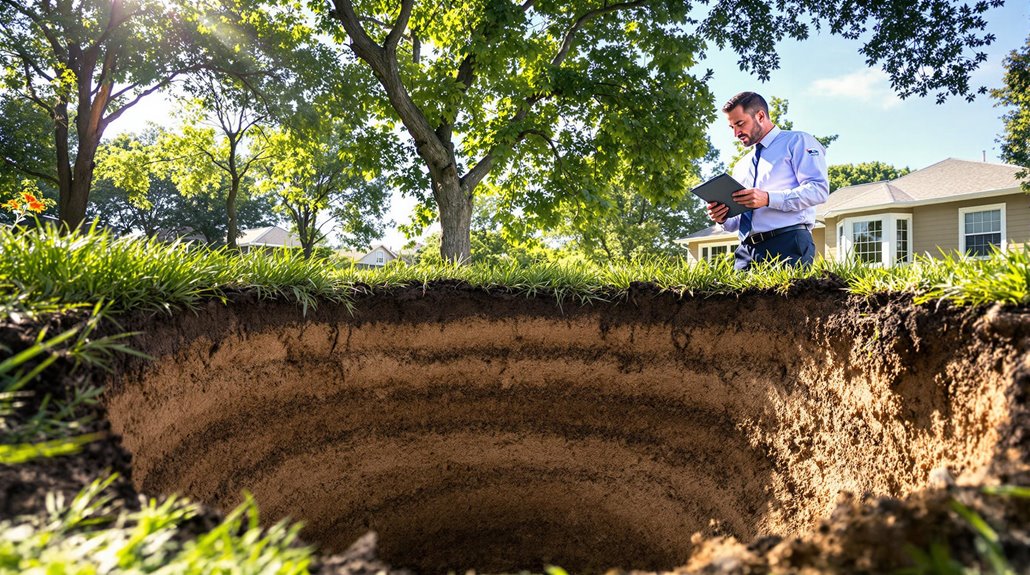
The Public Claims Adjusters Network (PCAN) serves as a professional organization connecting licensed public adjusters across multiple states and jurisdictions. This network facilitates the sharing of expertise, claims negotiation strategies, and best practices among licensed professionals who advocate for policyholders.
Members of PCAN must maintain state licensing requirements and demonstrate proficiency in public adjuster roles, including damage assessment and policy interpretation.
- PCAN members collaborate on complex cases, particularly those involving sinkholes and geological hazards, leveraging collective experience to maximize claim settlements.
- The network maintains strict ethical standards and provides ongoing professional development to guarantee members stay current with industry regulations.
- Through PCAN's resource sharing platform, public adjusters can access specialized documentation tools and proven methodologies for claims processing.
The organization's structured approach to claims management enables more efficient resolution of property damage cases while maintaining the highest standards of professional conduct and client advocacy.
Frequently Asked Questions
How Much Does It Typically Cost to Repair a Residential Sinkhole?
Residential sinkhole repair costs typically range from $10,000 to $100,000, depending on size and severity. Insurance coverage varies by region, with extensive remediation requiring professional engineering assessment and specialized materials.
Can Sinkholes Be Filled With Concrete as a Permanent Solution?
Sinkhole filling with concrete is not recommended as a permanent solution, as it fails to address underlying causes and may exacerbate soil erosion, potentially leading to further structural instability beneath.
Does Homeowners Insurance Automatically Cover Sinkhole Damage and Repairs?
Standard homeowners insurance policies typically exclude sinkhole damage. Property owners must obtain specialized coverage options through additional endorsements or separate sinkhole insurance to protect against these geological hazards. Many insurance companies offer sinkhole insurance coverage as an optional add-on, allowing homeowners to mitigate potential financial losses from such events. It’s important for property owners to thoroughly understand their policy options and the terms of coverage, as coverage can vary significantly between insurers. For those considering this protection, it is essential to consult with a knowledgeable agent who can provide insights into sinkhole insurance coverage explained, ensuring homeowners make informed decisions about their risk management strategies.
How Long Does a Professional Sinkhole Assessment and Repair Usually Take?
Like peeling back layers of an onion, sinkhole assessment typically requires 1-3 days for diagnosis, while repairs can extend from several days to multiple weeks, depending on severity and method chosen.
Can Tree Roots or Water Leaks Cause Sinkholes in My Yard?
Tree root causes include pipe infiltration and structural damage, while water leak effects create underground erosion. Both factors greatly contribute to sinkhole formation by destabilizing soil and creating subsurface voids.
References
- https://www.un-spider.org/sinkholes
- https://www.studocu.com/en-us/messages/question/9666018/for-this-project-you-will-write-an-article-about-a-stem-related-issue-for-a-scientific-blog-that
- https://www.obms.us/Faq.aspx?QID=103
- https://quizlet.com/581644328/comm-2613-quiz-5-7-flash-cards/
- https://exactrecon.com/steps-to-take-if-you-suspect-a-sinkhole-on-your-property/
- https://www.puroclean.com/moraine-oh-puroclean-emergency-services/blog/how-to-fix-a-sinkhole-what-you-need-to-know/
- https://www.dirtconnections.com/how-to-fill-a-sinkhole-in-your-yard-using-dirt/
- https://lafd.org/news/life-saving-rescue-growing-sinkhole
- https://www.fairfaxcounty.gov/soil-water-conservation/drainage-problem-sinkhole
- https://www.exponent.com/capabilities/sinkholes


